I am fairly new to python and ploty (<3 months of actual coding at this point). I am trying to create subplots in plotly. I have created graphs in plotly using the code below(code snippets attached below as well), but I can't seem to get them to work using subplots
I create many of these types of data graphs and any help in tightening my code would be much appreciated.
Here is a sample dataset (below is the only way I know how to line it up on this site??) [NOTE: it is not the exact same dataset I used to generate the graphs below, but close enough]:
subjid_raw studyarm visit pn_chg fx_chg totw_chg
20001 B 02_ASCRN -1 -28 -30
20001 B 02_DAY001 0 0 0
20001 B 02_DAY029WK4 -12 -56 -76
20001 B 02_DAY092WK13 -17 -61 -88
20001 B 02_DAY183WK26 -19 -64 -93
20001 B 02_DAY274WK39 -13 -45 -65
20001 B 02_ZEOS -22 -70 -102
20001 B MTH06 -22 -74 -108
20001 B MTH12 -23 -74 -109
20005 C 02_ASCRN 3 8 12
20005 C 02_DAY001 0 0 0
20005 C 02_DAY029WK4 -20 -80 -112
20005 C 02_DAY092WK13 -16 -68 -95
20005 C 02_DAY183WK26 -22 -69 -99
20005 C 02_DAY274WK39 -19 -71 -103
20005 C 02_ZEOS -4 -26 -36
20005 C MTH06 -17 -76 -105
20005 C MTH12 -22 -72 -106
20007 D 02_ASCRN -13 2 -12
20007 D 02_DAY001 0 0 0
20007 D 02_DAY029WK4 6 -15 -45
20007 D 02_DAY092WK13 -10 -26 -39
20007 D 02_DAY183WK26 -19 -72 -97
20007 D 02_DAY274WK39 -4 -30 -35
20007 D 02_ZEOS -25 -71 -103
20007 D MTH12 -24 -85 -117
20010 A 02_ASCRN -5 -2 -6
20010 A 02_DAY001 0 0 0
20010 A 02_DAY029WK4 -24 -75 -102
20010 A 02_DAY092WK13 -3 1 -1
20010 A 02_DAY183WK26 -2 7 6
20010 A 02_DAY274WK39 1 9 13
20010 A 02_ZEOS -6 -1 -7
NEED: I would like to have the subplots show as a subplot with two rows and two columns (although I am not sure that will work given there are only three columns of data to graph??)
import pandas as pd ##(version: 0.22.0)
import numpy as np ##(version: 1.14.0)
import plotly.graph_objs as go
import plotly.tools as tls
from plotly.offline import *
import cufflinks as cf ##(version: 0.12.1)
init_notebook_mode(connected=True)
cf.go_offline()
dummy_data = pd.read_csv("desktop\dummy_data.csv")
a = dummy_data.groupby(['studyarm', 'visit']) ['fx_chg'].mean().unstack('studyarm').drop(['02_UNSCH','ZEOS'])
b = dummy_data.groupby(['studyarm', 'visit']) ['pn_chg'].mean().unstack('studyarm').drop(['02_UNSCH','ZEOS'])
c = dummy_data.groupby(['studyarm', 'visit']) ['totw_chg'].mean().unstack('studyarm').drop(['02_UNSCH','ZEOS'])
fig3 = a.iplot(kind='line', yTitle='Score', title='Dummy Data1', mode=markers, asFigure=True)
fig3['data'][0]['marker']['symbol'] = 'hexagram-open-dot'
fig3['data'][1]['marker']['symbol'] = 'circle-dot'
fig3['data'][2]['marker']['symbol'] = 'star-open-dot'
fig3['data'][3]['marker']['symbol'] = 'square'
iplot(fig3, filename='simple-plot')
fig4 = b.iplot(kind='line', yTitle='Score', title='Dummy Data2', mode=markers, asFigure=True)
fig4['data'][0]['marker']['symbol'] = 'hexagram-open-dot'
fig4['data'][1]['marker']['symbol'] = 'circle-dot'
fig4['data'][2]['marker']['symbol'] = 'star-open-dot'
fig4['data'][3]['marker']['symbol'] = 'square'
iplot(fig4, filename='simple-plot')
fig5 = c.iplot(kind='line', yTitle='Score', title='Dummy Data3', mode=markers, asFigure=True)
fig5['data'][0]['marker']['symbol'] = 'hexagram-open-dot'
fig5['data'][1]['marker']['symbol'] = 'circle-dot'
fig5['data'][2]['marker']['symbol'] = 'star-open-dot'
fig5['data'][3]['marker']['symbol'] = 'square'
iplot(fig5, filename='simple-plot')
## I have tried all forms of
##fig = tls.make_subplots(rows=n, cols=n) ##but it just shows graphs as blank?
Any help or nudge in the right direction would be appreciated.
<iframe width="900" height="800" frameborder="0" scrolling="no" src="//plot.ly/~t3c/29.embed"></iframe><iframe width="900" height="800" frameborder="0" scrolling="no" src="//plot.ly/~t3c/31.embed"></iframe><iframe width="900" height="800" frameborder="0" scrolling="no" src="//plot.ly/~t3c/34.embed"></iframe>